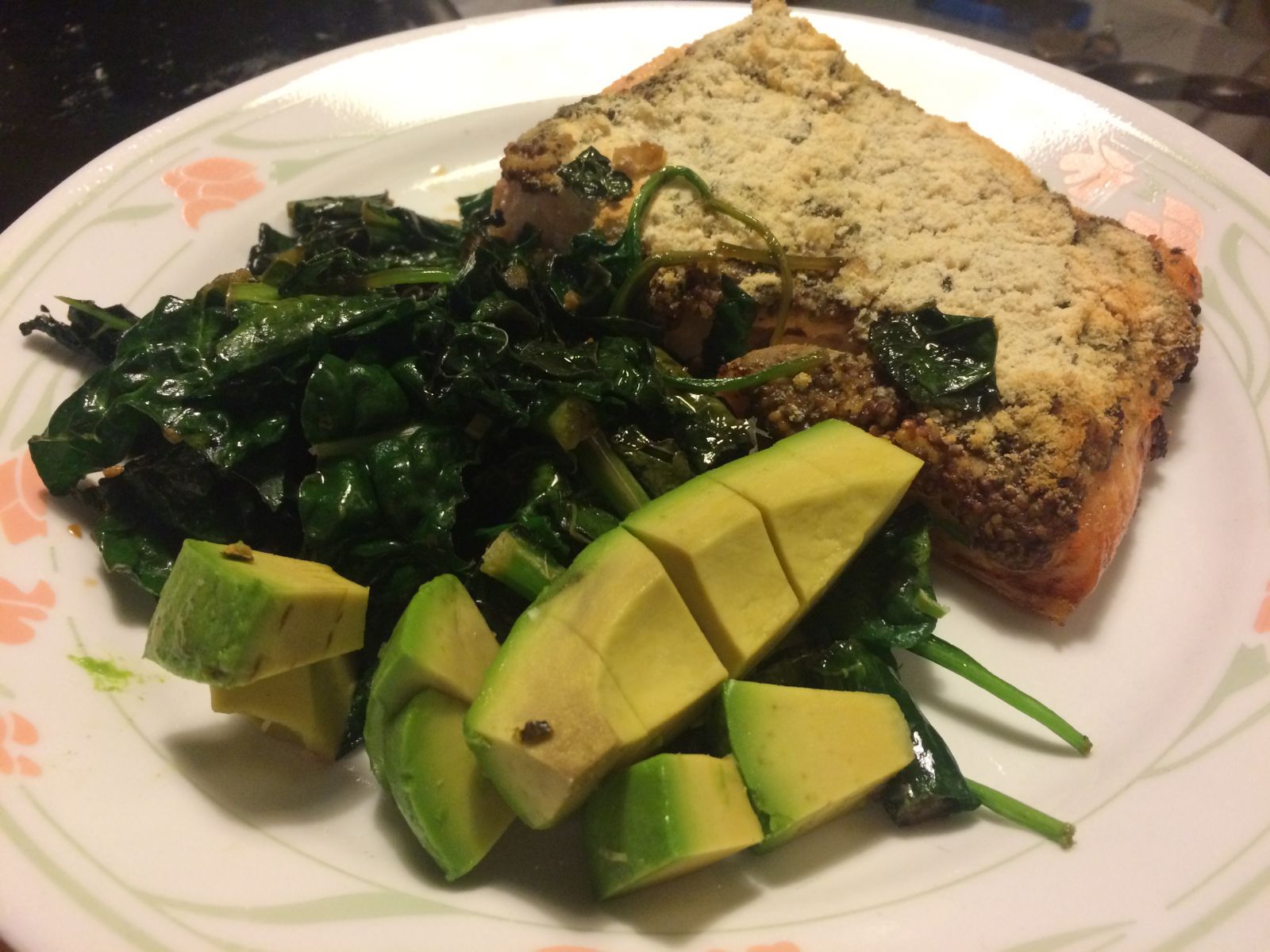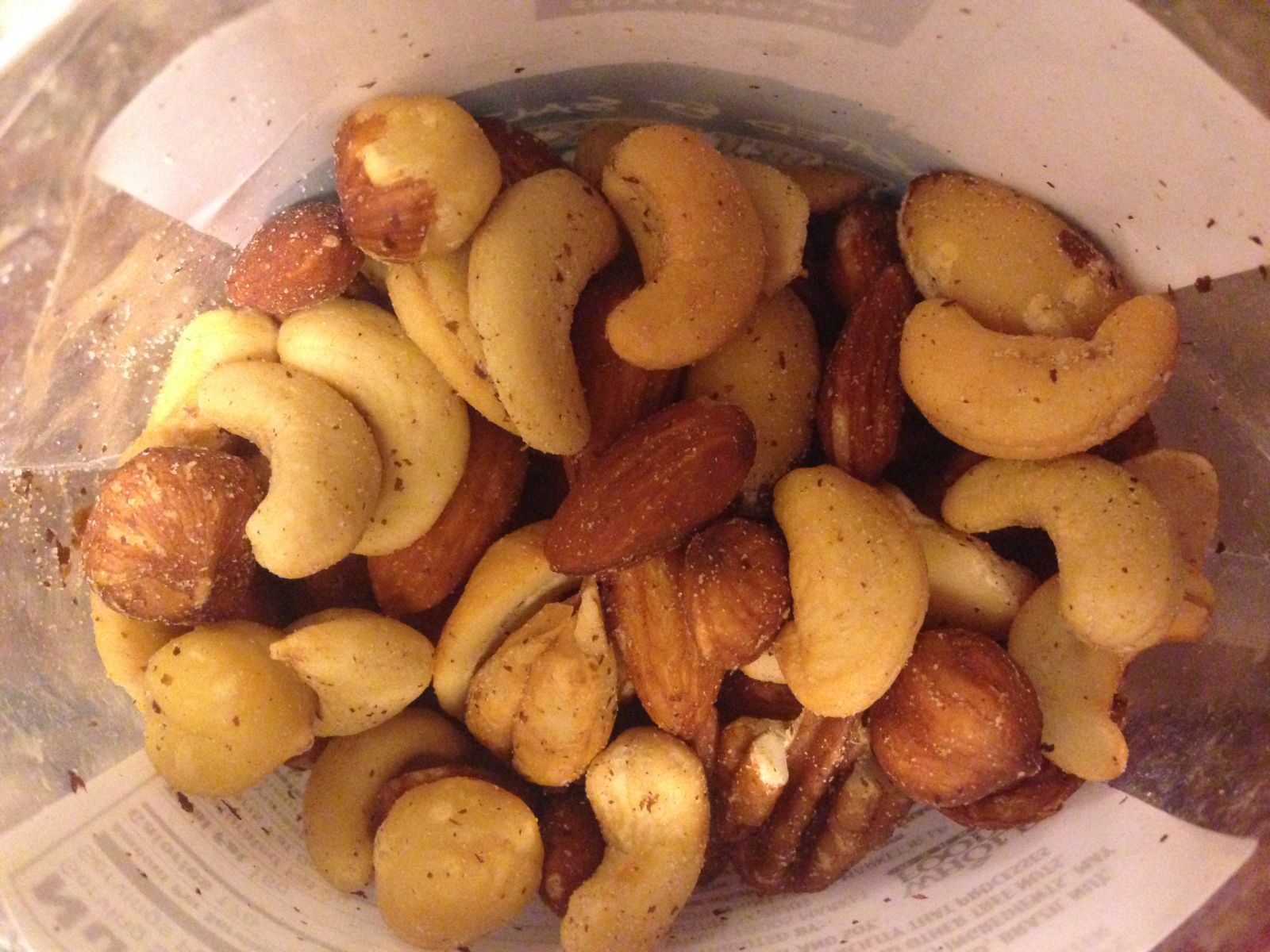What I Actually Eat – Taking My Diabetes Diet Commandments Into Daily Life
By Adam Brown
.png) by Adam Brown
by Adam Brown
Twitter Summary: Taking my 10 #diabetes #diet commandments to breakfast, lunch, dinner, and snacks at home + answers to frequently asked questions
I recently shared the 10 Diabetes Diet Commandments that I strive to follow every day. These eating strategies help keep my blood sugars in range, give me plenty of energy, keep my weight stable, are transportable to different eating environments, and fit within my budget. But since commandments can feel somewhat theoretical and idealistic, this article lists the actual foods I eat at different meals. When applicable, I’ve added links to recipes or particular items I order online. I’ve also answered some of the most frequently asked questions readers send me (number of carbs, cost, prep time, taste, energy levels, getting teens to eat better, and more).
Eating is very personal, and I do not believe that my approach is for everyone – or, obviously, that there is one "right" approach! I’ve shared the below in case it is useful, especially because a number of diaTribe readers have asked me, “What do you eat?” But as I said last month, I highly recommend making a list of your own personal diet commandments for eating with diabetes. The key is to find eating strategies and foods that work for your diabetes, your taste preferences, your budget, and your time constraints. That said, I hope my approach has some universal themes that everyone can benefit from, including a heavy emphasis on vegetables, healthy fats (nuts, seeds, olive oil), foods cooked at home, and eliminating processed foods as much as possible. Please let me know what you think by email or on Twitter..jpg)
Breakfast Examples
-
Scrambled eggs/egg whites with vegetables (spinach, peppers, mushrooms)
-
Smoothie: Blend 1.5 cup frozen spinach, ~1 tsp cinnamon, 1 tbsp chia seeds, 1.5 cups water, one scoop vanilla whey protein powder. Optional: frozen blueberries/raspberries/strawberries, unsweetened almond milk, avocado
-
If you don’t have protein powder, here are two options – option A (less expensive) or option B (higher quality but more expensive). Both still average out to ~$1.50 or less per breakfast.
-
[Note: This may sound disgusting, but is quite tasty with the right protein powder and cinnamon. Frozen spinach has virtually no flavor. It’s also a very filling meal to start the day. I usually have this after exercising in the morning and take the equivalent amount of insulin to cover 15 grams of carbs.]
-
-
Almonds, peanuts, mixed nuts (roasted and unsalted; especially helpful when I’m running high in the morning or on-the-go)
-
Almond flour blueberry pancakes or bagels (add blueberries)
-
Note: You can generally substitute almond or coconut flour for any recipe that calls for flour or breadcrumbs– the result is a much lower spike in blood glucose. Here is the kind I buy.
-
-
Loose leaf green tea
 Lunch Examples
Lunch Examples
-
Lentils with whatever vegetables I have on hand. Topped with salsa, Sriracha, various spices, or parmesan cheese. (Costs less than $0.50 per meal, is very filling, and very-easy-to make – just throw it all in a pot of water on low heat and come back in 15 minutes. It has a slow impact on blood sugar and is packed with fiber.)
-
Salad with chicken or salmon, balsamic vinegar dressing on the side (traps I avoid: croutons, dried fruit, ranch dressing)
-
Open-faced turkey sandwich (once single slice of whole grain bread) with side salad
-
Almonds, peanuts, mixed nuts
 Dinner Examples
Dinner Examples
-
Vegetables: broccoli, spinach, kale, brussel/kale sprouts, bell peppers, mushrooms, squash, zucchini
-
Steamed: Generally I heat on the stove or in microwave, topped with a bit of parmesan cheese, low sodium soy sauce, balsamic vinegar, or various spices.
-
Sautéed on stove top: Olive oil and garlic
-
Roasted in oven with olive oil + salt/pepper
-
-
 Ground turkey + vegetables (see above):
Ground turkey + vegetables (see above):-
Meatballs (leave out the bread crumbs or substitute almond flour)
-
Stir fried in pan with salsa and whatever vegetables I have on hand
-
Salmon + vegetables (see above):
-
Sautéed on stove top with olive oil and garlic
-
-
Chicken (breasts, thighs) + vegetables (see above)
-
Cooked on George Foreman Grill with spices
-
Sliced up and sautéed on stove top with garlic, low sodium soy sauce, and olive oil
-
Calamari grilled on George Foreman with Italian seasoning
-
Ratatouille (stewed vegetables)
-
Cauliflower pizza (Almond flour works a bit better than Cauliflower in terms of getting a more authentic crust, but Cauliflower is lower in calories)
-
Kale+spinach bites (use almond flour instead of bread crumbs, avoid the butter)
-
Roasted delicata squash (this recipe is for acorn squash, but you can substitute Delicata squash, and it tastes just like French Fries!)
 Dessert Examples
Dessert Examples
-
Fruit: frozen raspberries, frozen blueberries, frozen strawberries (I make sure no sugar has been added; the only ingredient should be the fruit!)
-
Sliced apple with cinnamon and peanut butter (I buy the kind you need to stir with just peanuts + salt as the ingredients)
-
Almonds, peanuts, mixed nuts
-
Peppermint tea mixed with raw dark chocolate cocoa powder (zero carbs and tastes like Mint Chocolate chip)
 Snack Examples
Snack Examples
-
Almonds, peanuts, mixed nuts – A running theme in this article, as I do eat a lot of nuts! They are probably the most expensive part of my diet, but also packed with nutrients, fiber, and have a slow impact on blood sugar.
-
Loose leaf green tea (Pretty filling and zero calories; I buy this kind from Upton Tea)
-
Pumpkin seeds
-
Sliced apple with peanut butter
-
Steamed vegetables with parmesan cheese
Answers to Frequently Asked Questions
Q: You tend to eat lower carb than the ADA and many nutritionists recommend. Is that safe for people with diabetes?
A: The ADA’s 2014 Nutrition Therapy Recommendations note, “Evidence is inconclusive for an ideal amount of carbohydrate intake for people with diabetes. Therefore, collaborative goals should be developed with the individual with diabetes.”
I totally agree with that statement. Nutrition studies can be confusing, and data is often conflicting. As we wait for answers from efforts like the Nutrition Science Initiative, I’ve come to rely on my own trial and error, and this way of eating really works well for me on several fronts: diabetes, weight, general health, energy, taste, and budget. I absolutely don’t believe it is for everyone – some can and will do just as well on more carbs per day. If every dose of insulin is like firing at a target, I have found that eating low carb is like using a bow and arrow instead of a cannon: it’s more precise, more tactical, and there’s less potential for damage.
The approach I’ve outlined generally results in about 120 grams of carbohydrates per day, which is slightly below the Institute of Medicine’s “Acceptable Daily Minimum Requirement” of 130 grams. Personally, I have not seen any adverse effects on days with 120 grams of carb or lower. That said, I am used to eating this way, so those who try it for the first time may experience side effects (e.g., lower energy); in my experience, these pass as your body gets accustomed to this eating approach.
Q: You are a pretty active person – how do you get enough carbs to support your exercise and energy levels?
A: I cycle about 80 miles per week, strength train three days per week, and average 10,000+ steps per day, so I am indeed active! Perhaps surprisingly, I’ve found that my approach to eating enables this activity without much of a problem. [The one exception is when I’m cycling for more than 90 minutes at a time – I eat more carbs before, during, and after exercise.] In terms of human biology, calories from any food source can be utilized for long-duration physical exercise, so a diet higher in fat and protein can still fuel high-level activity.
I find my energy levels are primarily tied to two things: blood sugars and the amount of sleep I get. This diet approach seems to keep my blood sugars in range for more of the day, and consequently, gives me more energy than other eating styles. And if I stick to my diet commandments, I end up sleeping better, since I don’t eat close to bedtime (#8).
Q: How expensive is it to eat this way?
A: I generally spend about $80 a week on groceries for myself, which averages out to roughly $5 per meal; I get everything I need at Trader Joe’s once per week, with an occasional Amazon order. Nuts are by far the most expensive part of my diet, particularly as almond prices have risen markedly here in California. [I’ve transitioned more to peanuts as a lower-cost alternative.] Fruits and vegetables are remarkably cheap here in California; I try to buy organic when it’s reasonable to do so, and frozen berries and broccoli/spinach are staples.
Q: How much time do you spend cooking?
A: Nearly everything takes me 30 minutes or less to make – and I am very far from an expert in the kitchen! I cook most things on the stovetop, with occasional use of the oven. I generally steam vegetables in the microwave. The only non-traditional kitchen appliances I use are a Nutri Ninja blender ($89) and a George Foreman Grill ($30). [Note, if you shop at Amazon for these or other products, check out Amazon smile and consider donating to The diaTribe Foundation at no extra cost to you!].
Q: How do you make food tasty but in a healthy way?
A: Spices: salt and pepper; fresh chopped garlic; and Italian seasoning.
Condiments: Balsamic vinegar (salad dressing); cinnamon; chia seeds; Dijon whole grain mustard; parmesan cheese; salsa; soy sauce (low sodium); and Sriracha.
Q: My teenager has diabetes, but eats more junk food than I’d like. Do you have any recommendations?
A: I actually ate very poorly as a teenager, including frequent fast food trips, pizza, hot dogs, Goldfish crackers, cookies, ice cream, diet soda, etc. I also ran an A1c in the 8%-9% range! [More recently, my A1c has been in the 6.2%-6.5% range.] The problem was two-fold: this stuff was in the house, so it was easily accessible (I don’t fault my mom at all, but having it in the pantry did make it easier to eat); and second, I didn’t recognize the value of eating a healthy diet. It wasn’t until college that I learned about nutrition and had more control of my own diet. Getting on CGM also helped me realize the direct blood sugar impact of my dietary choices. So for parents, consider (i) what foods you buy and cook, since easy accessibility drives consumption; (ii) how your teen might learn about nutrition and eating well (I recognize this is pretty hard); and (iii) whether CGM might be right for you.
Q: Is it awkward to eat this way in a social setting?
A: My friends and family know that I eat this way, and will actually go out of their way to help me. I actually welcome people saying, “Wait – is there anything for Adam to eat at the pizza place?” Some don’t like feeling “special” or “the person with diabetes,” but I appreciate when others look out for me. And now that my friends and family know how I eat, it’s a social expectation that I am not tempted to break. In other words, even when I’m tempted to indulge, I feel like I’ve publicly committed to my commandments – that makes it much harder to make exceptions.
Q: I have a few guilty pleasure foods that I don’t think I can give up. What do you advise I do, and how do you approach your own guilty pleasure foods?
A: I recommend setting the ground rules for when you will eat guilty pleasure foods ahead of time. For example, like I said in my last article on this, there are two major times where I chose to eat outside my commandments:
1. I break the sugar/carb commandments when I’m doing long bike rides (usually once per week). At these times, I drink Gatorade, eat Clif bars, and eat traditionally baked goods.
2. I break my white rice/<30 g carb commandments when eating sushi, one of my favorite foods (typically every other week).
Can you make a list of ground rules for your guilty pleasure exceptions? Other things you could try:
-
Buying your guilty pleasure foods in limited quantities, or better, in snack size versions (e.g., 2 ounce packs instead of one pound);
-
Making it less convenient to eat your guilty pleasure foods (tying up the bag really tight, hiding it far back in the cupboard);
-
Only eating your guilty pleasure foods when you’ve gotten a certain minimum level of exercise for the day;
-
Telling your friends and family that you want to eat less of your guilty pleasure foods, and giving them license to police you;
-
Mentally linking enough pain to eating your guilty pleasure food.
-
Remember what motivates you to manage your diabetes – to be a more pleasant person, to see your kids grow up, to run your first 10k, etc.
Q: If you had to sum up your approach to eating in one sentence, what would you say?
A: In the words of the great Michael Pollan, “Eat food. Not too much. Mostly plants.”







